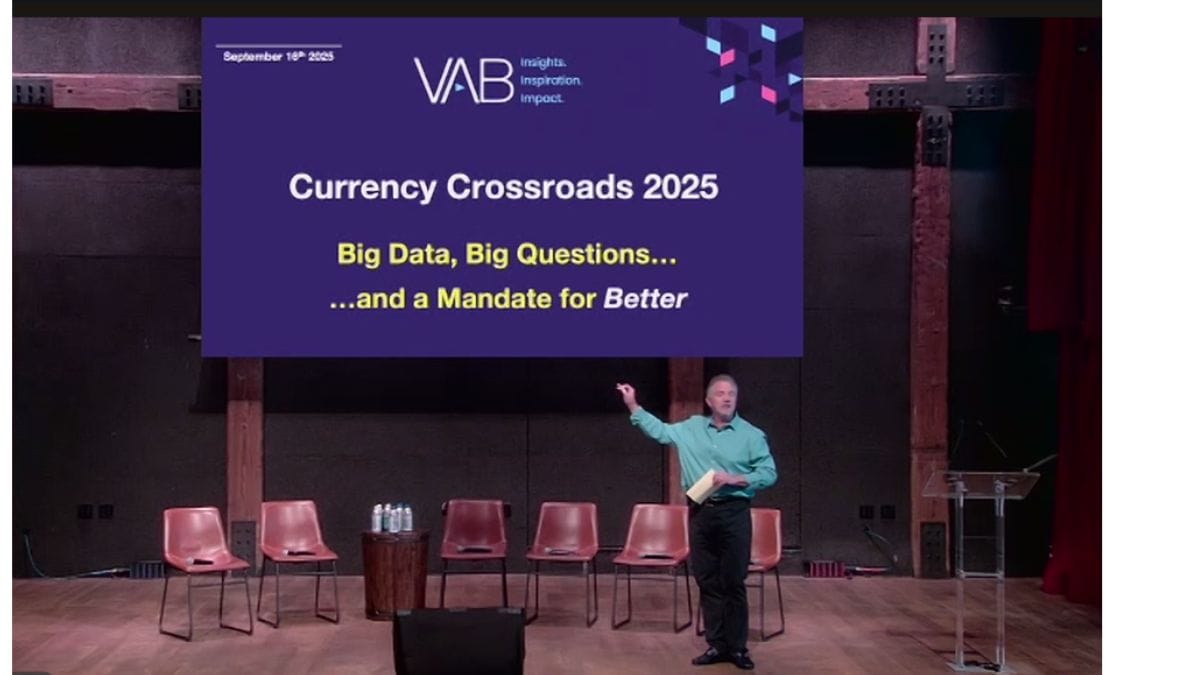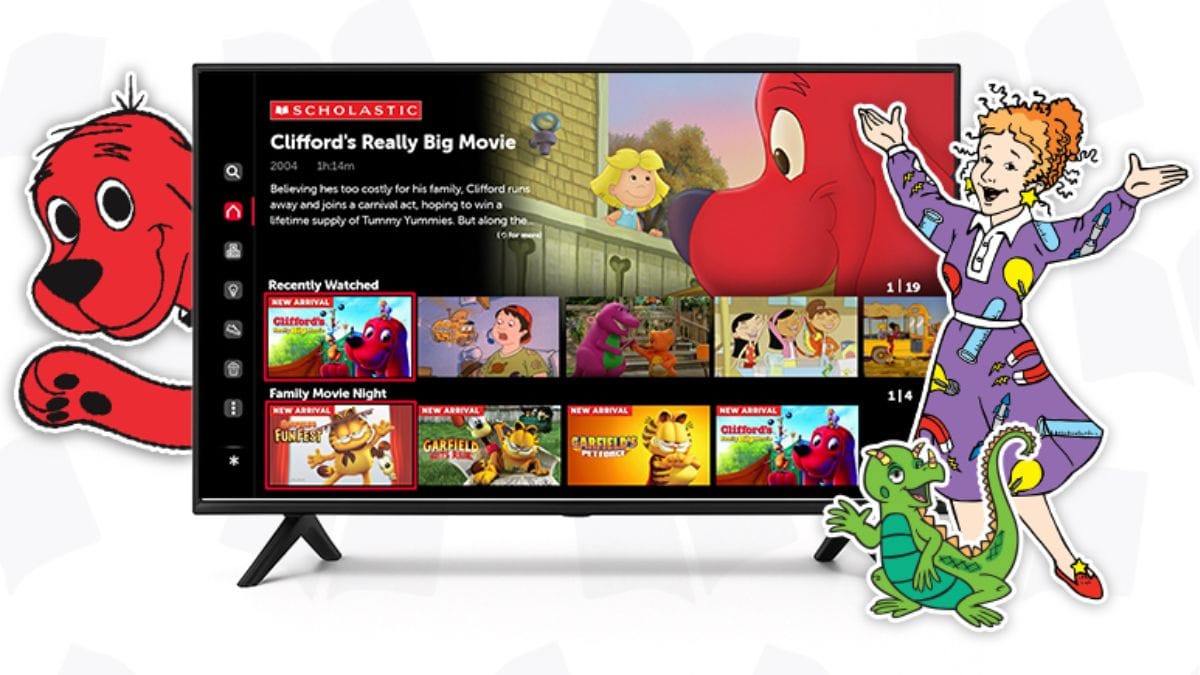VAB’s Sean Cunningham Blitzes Nielsen’s ‘Big Data’ at CIMM Conference
'How do you go from a panel of 44,000 to 45 million [homes supplying data] and actually you’re deepening your undercount?' Cunningham wondered

Sean Cunningham, CEO of the VAB, which represents TV networks and distributors, took his complaints about Nielsen and its new Big Data + Panel methodology to the stage of the Coalition for Innovative Media Measurement’s Summit conference Tuesday.
Cunningham argued that the new measurement system seems to confirm Nielsen’s old panel-only numbers, which he contended undercounts millions of viewers and saddles linear networks with double-digit year-over-year declines that are accelerating on a month-by-month basis.
Other creditable data sets show linear TV getting bigger viewership numbers and less dramatic drops, he said.
Nielsen, which has long dominated the TV measurement business, has long had its share of critics. And over the past few years, Cunningham has been among the most prominent.
No one argues that linear ratings aren't going down while streaming is on the rise. But the rate of change is crucial to networks that depend on advertising revenue and beng able to make accurate predictions about the eyeballs they will deliver in the new TV season.
The TV business has largely wrapped up its upfront sales season, where the pieces for the bulk of commercials for 2025-26 are negotiated.
Cunningham said that many of the networks that are members of the VAB had “a lot of trouble estimating and forecasting coherently because [Big Data + Panel] was inconsistent and it was unstable. Some people were able to pull it off. Many weren’t.”
Nielsen promised that Big Data was going to fix the problems caused by blind spots in a small panel-based system trying to measure a fragmenting TV landscape, Cunningham said. It was going to “usher in a new era of accountability, accuracy, stability and predictability,” he said.
Instead the networks that subscribe to Nielsen can’t get answers when they question “instability, inconsistency, illogical results and irrational fluctuations” in the Big Data + Panel ratings. Millions of viewers are still missing, especially in key demos including adults 25-to-54, which is showing double-digit declines.
Despite the VAB’s complaints, most of the major networks have extended their contracts with Nielsen, which means they’re using the Big Data + Panel numbers. That includes Paramount Global, which let its Nielsen deal lapse last October, but returned to the fold in February. Just last week, Warner Bros. Discovery signed a new agreement to use Nielsen’s Big Data + Panel ratings. Most of the big agencies are signed up as well.
The networks and agencies held meetings with Nielsen about their concerns in separate meetings in June. Nielsen addressed some of the issues, but concluded that other changes weren’t necessary because the numbers were accurate as far as Nielsen could tell.
When Nielsen officially made Big Data+Panel its official currency this month, Nielsen CEO Karthik Rao declared that Big Data + Panel was a huge advance for the industry.
“The embrace of Big Data + Panel ratings marks a once in a generation enhancement for the industry,” Rao said. “Combining the trusted, historical measurement of our Nielsen homes with millions of big data inputs gives us the most accurate numbers ever. We developed this measurement advancement in service of and in collaboration with our clients. We are proud to work with them to deliver these numbers for the new season.”
A Nielsen spokesperson declined to comment on Cunningham's presentation.
At CIMM, Cunningham said he and the VAB had a theory about why Nielsen's new methodology wasn’t any better than its older one.
“How do you go from a panel of 44,000 to 45 million [homes supplying data] and actually you’re deepening your undercount?” he asked. “It’s only possible if your priority is to ensure that the Big Data results look nearly identical to the legacy results from a database that’s 11 times smaller"
Cunningham said that instead of using its panel to calibrate the demography of its big data, it was using “the ailing panel data to manipulate the 45 million of new data to mirror the panel.”
He estimated that the new numbers from Nielsen were 70% to 80% drawn from the legacy panel and just 20% from big data.
“What happened was bending back to a quote, unquote, truth set that wasn't a truth set and that was ailing, damaged. But it was more important to find something that agreed with that,” Cunningham said.
Cunninghas told the CIMM audience that the industry needed to find the millions of viewers that are being undercounted.
“This isn't a ‘Nielsen must go away kind of thing.’ No. I just want them to get way better at what they're doing, and they won't until there's a second data set in there that we can use for currency,” he said.
Measurement companies including ispot, VideoAmp and Comscore their own viewership figures based on big data.
Cunningham said that it was important that the industry get stable, consistent, predictable data lest it face extinction. And it would be nice if that happened before the next upfront.
“We don't have a lot of time. June 2026 is going to come fast,” he concluded. “Marketers, advertisers, agencies, publishers. What more do you need to see?”
# # #
At the CIMM conference, VideoAmp CEO Peter Liguori expressed his frustration at not being able to make more of a dent in Nielsen’s dominance of the TV measurement business.
He scoffed at some of the justifications he’s heard from clients that, despite dissatisfaction, continued to renew their contracts with Nielsen.
He said some claimed to prefer Nielsen's panel. He said that was fair, but noted that while Nielsen was panel forward, VideoAmp was big-data forward. Others claimed that accreditation by the MRC was important. VideoAmp is in the middle of the accreditation process, but Liguori was skeptical that getting that seal of approval would change things.
Finally, he heard from some potential clients that they can’t afford VideoAmp–which costs a fraction of what Nielsen charges for its multi-year fixed-fee contracts. “If I had a fixed-fee contract in this environment, I would use the other guy all day long. I wouldn’t care about innovation. I wouldn't care about whether the number makes sense," Liguori said.
Bottom line: of the $4 billion the industry spends on measurement, VideoAmp gets about 1%. “We’re probably doing something wrong, and I’d like to partner with you to figure that out,” he said.
Liguori noted that he’s heard that Nielsen’s data shows traditional TV viewership down about 20% year over year, falling faster in the second half of the year than the first half. For small cable network the drop is more like 30%.
“It’s an existential issue for those guys. If this continues. A loto f cable networks are going to go out of business,” he said.
By contrast, VideoAmp’s data shows a decline of about 8%
Liguori said the industry has made measurement changes in the past, such as when the networks insisted on getting paid for delayed viewing.
“We can do it together. And I’d say if we don't, we’re going to wind in in [the Museum of Natural History] visiting each other,” he warned.
# # #
9 Story Media Group and Future Today said they launched the first Scholastic-branded streaming app. Aimed at kids aged 2-13 and their families, the app is available on Roku and Amazon Fire TV.
The app features 400 hours of content including childhood favorites Clifford the Big Red Dog, The Magic School Bus, Goosebumps, The Baby-Sitters Club and Animmorphs. The app also has other shows from the 9 Story library including Garfield and Barney & Friends.


